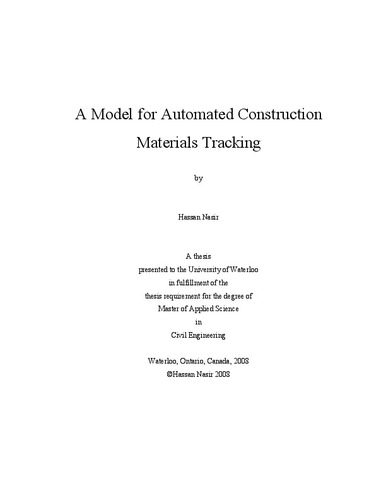| dc.contributor.author | Nasir, Hassan | |
| dc.date.accessioned | 2009-01-16 20:59:50 (GMT) | |
| dc.date.available | 2009-01-16 20:59:50 (GMT) | |
| dc.date.issued | 2009-01-16T20:59:50Z | |
| dc.date.submitted | 2008 | |
| dc.identifier.uri | http://hdl.handle.net/10012/4190 | |
| dc.description.abstract | Materials management is a critical factor in construction project performance, particularly in the industrial sector. Research has shown that construction materials and installed equipment may constitute more than 50% of the total cost for a typical industrial project. Therefore the proper management of this single largest component can improve the productivity and cost efficiency of a project and help ensure its timely completion. One of the major problems associated with construction materials management is tracking materials in the supply chain and tracking their locations at job sites. Identification is integral to this process. Research projects conducted during the last decade to automate the identification and tracking of materials have concluded that such automation can increase productivity and cost efficiency as well as improve schedule performance, reduce the number of lost items, improve route and site optimization, and improve data entry. However, these technologies have been rapidly evolving, and knowledge concerning their implementation is sparse. One new approach enables locating of components within a few meters at a cost at least a magnitude lower than preceding technologies. It works by combining GPS located reads of RFID tags read at a rate of several thousand Hertz in order to estimate the location of these inexpensive tags which are attached to key construction materials. This technology was rapidly prototyped and deployed on two large industrial construction projects in 2007 and 2008. This thesis analyzes and synthesizes the data and experiences from these unique and large scale field trials as well as the literature in order to develop a general implementation model for automated construction materials tracking for industrial projects. It is concluded from the model that this new automated construction materials tracking technology is likely to be successful if implemented full scale on well selected future projects. This conclusion is supported by subsequent industry decisions. | en |
| dc.language.iso | en | en |
| dc.publisher | University of Waterloo | en |
| dc.subject | Construction management | en |
| dc.subject | Automated tracking model | en |
| dc.subject | materials management | en |
| dc.subject | materials locating and tracking | en |
| dc.subject | RFID and GPS | en |
| dc.title | A Model for Automated Construction Materials Tracking | en |
| dc.type | Master Thesis | en |
| dc.pending | false | en |
| dc.subject.program | Civil Engineering | en |
| uws-etd.degree.department | Civil and Environmental Engineering | en |
| uws-etd.degree | Master of Applied Science | en |
| uws.typeOfResource | Text | en |
| uws.peerReviewStatus | Unreviewed | en |
| uws.scholarLevel | Graduate | en |

